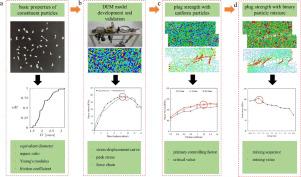Bed strength in sheared beds of mono- and bi-disperse particles: Dependence on geometrical and mechanical properties of constituent particles
IF 4.5
2区 工程技术
Q2 ENGINEERING, CHEMICAL
引用次数: 0
Abstract
Temporary plugging zones are low-permeability fracture-scale plugs ‘assembled’ in situ by injecting polymer particles into petroleum reservoirs. We applied the rolling resistance linear model to simulate the shear strength of a rectangular packed bed, our model for a temporary plugging zone, comprising either uniform-sized particles or a binary mixture of larger bridging particles and smaller filling particles. Simulation results show that the strength of uniform beds increases with the size, the aspect ratio, the friction coefficient, and the Young’s modulus of the particles. The strength of binary packed beds first increased and then decreased as the fractional volume of the domain occupied by filling particles increased. Maximum strength was achieved when bridging particles have uniform Young’s modulus and aspect ratio but a range of friction coefficients, and their friction coefficient, Young’s modulus and aspect ratio are 21%, 17% and 18% larger than those of filling particles.

单分散和双分散颗粒剪切床的床层强度:与组成颗粒的几何和机械特性有关
临时封堵区是通过向石油储层注入聚合物颗粒而在原地 "组装 "的低渗透裂缝规模封堵区。我们采用滚动阻力线性模型模拟了矩形填料床的剪切强度,这是我们的临时堵塞区模型,由均匀尺寸的颗粒或较大桥接颗粒和较小填充颗粒的二元混合物组成。模拟结果表明,均匀床的强度随颗粒大小、长宽比、摩擦系数和杨氏模量的增加而增加。二元填料床的强度随着填料颗粒所占领域体积分数的增加而先增后减。当桥接颗粒具有统一的杨氏模量和长宽比,但摩擦系数在一定范围内,且其摩擦系数、杨氏模量和长宽比分别比填充颗粒大 21%、17% 和 18%时,强度最大。
本文章由计算机程序翻译,如有差异,请以英文原文为准。
求助全文
约1分钟内获得全文
求助全文
来源期刊

Powder Technology
工程技术-工程:化工
CiteScore
9.90
自引率
15.40%
发文量
1047
审稿时长
46 days
期刊介绍:
Powder Technology is an International Journal on the Science and Technology of Wet and Dry Particulate Systems. Powder Technology publishes papers on all aspects of the formation of particles and their characterisation and on the study of systems containing particulate solids. No limitation is imposed on the size of the particles, which may range from nanometre scale, as in pigments or aerosols, to that of mined or quarried materials. The following list of topics is not intended to be comprehensive, but rather to indicate typical subjects which fall within the scope of the journal's interests:
Formation and synthesis of particles by precipitation and other methods.
Modification of particles by agglomeration, coating, comminution and attrition.
Characterisation of the size, shape, surface area, pore structure and strength of particles and agglomerates (including the origins and effects of inter particle forces).
Packing, failure, flow and permeability of assemblies of particles.
Particle-particle interactions and suspension rheology.
Handling and processing operations such as slurry flow, fluidization, pneumatic conveying.
Interactions between particles and their environment, including delivery of particulate products to the body.
Applications of particle technology in production of pharmaceuticals, chemicals, foods, pigments, structural, and functional materials and in environmental and energy related matters.
For materials-oriented contributions we are looking for articles revealing the effect of particle/powder characteristics (size, morphology and composition, in that order) on material performance or functionality and, ideally, comparison to any industrial standard.
 求助内容:
求助内容: 应助结果提醒方式:
应助结果提醒方式:


